History
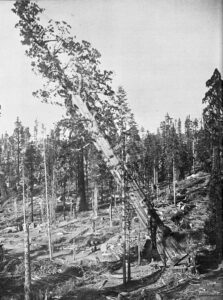
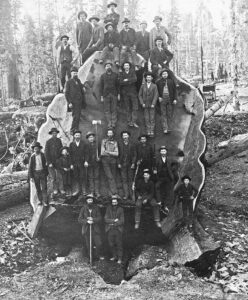 If you have ever wondered about the stupid things people can do, consider this. Most people have heard about the Redwoods in California. Trees just seem to grow much bigger in California, and if you have ever toured the Redwood National and State Parks, you will know what I mean. There is also a Sequoia National Park, and bordering that the Kings Canyon National Park, which was the location of the Mark Twain Tree…a giant sequoia tree located in the Big Stump Forest of Kings Canyon National Park. The giant tree was named after the American writer and humorist Mark Twain. The tree stood 331 feet tall and stretched 16 feet in diameter. It was an amazing tree, but there were people back East and in Europe who did not believe that trees could grow that big. In the late 1800s, travel across the country or from Europe just to see a big tree, was apparently not feasible. Now, I get that it could be difficult, and I get that the government wanted to prove that the tree existed, but what they did was no more than a display of stupidity.
If you have ever wondered about the stupid things people can do, consider this. Most people have heard about the Redwoods in California. Trees just seem to grow much bigger in California, and if you have ever toured the Redwood National and State Parks, you will know what I mean. There is also a Sequoia National Park, and bordering that the Kings Canyon National Park, which was the location of the Mark Twain Tree…a giant sequoia tree located in the Big Stump Forest of Kings Canyon National Park. The giant tree was named after the American writer and humorist Mark Twain. The tree stood 331 feet tall and stretched 16 feet in diameter. It was an amazing tree, but there were people back East and in Europe who did not believe that trees could grow that big. In the late 1800s, travel across the country or from Europe just to see a big tree, was apparently not feasible. Now, I get that it could be difficult, and I get that the government wanted to prove that the tree existed, but what they did was no more than a display of stupidity.
So, the solution was hatched. In 1891, the US Army arrived in California. Their mission was simple. Cut down 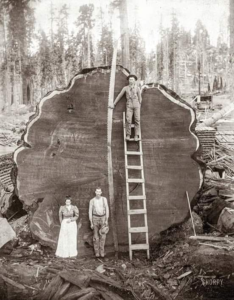 the famous Mark Twain tree so that slices of it could be sent to the American Museum of Natural History. In what is now Kings Canyon National Park, soldiers approached the giant sequoia tree and promptly cut it down. The tree, well known as it was, inspired wonder and doubt from those who had heard about it. Slices of the Mark Twain Tree were sent back to the East Coast and Europe, where it was displayed at museums in New York and London.
the famous Mark Twain tree so that slices of it could be sent to the American Museum of Natural History. In what is now Kings Canyon National Park, soldiers approached the giant sequoia tree and promptly cut it down. The tree, well known as it was, inspired wonder and doubt from those who had heard about it. Slices of the Mark Twain Tree were sent back to the East Coast and Europe, where it was displayed at museums in New York and London.
The project took 13 days and was carried out by lumbermen Bill Mills and SD Phips, with assistance from Barney and John Lukey. The tree was later shipped to the American Museum of Natural History in New York and the British Museum in London at the expense of Collis P Huntington, the president of the Southern Pacific Railroad. I suppose it is easy enough to understand why people couldn’t believe the huge trees were real. And for the Sequoia trees, even though the Sequoia National Park was established in 1890, access to the sequoia groves was difficult and the existence of such large trees was not widely believed at the time. I suppose some people might think that could justify the actions of the US Army and the US government, but to me it was a travesty, and a complete display of stupidity. So, to prove the tree could grow that big, they killed it, so they couldn’t see how big it could really grow. All to prove a point, 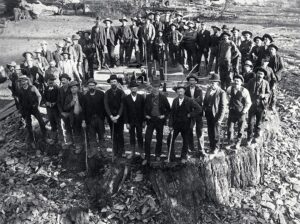
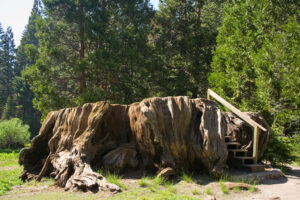 because there were those who thought the story was bogus.
because there were those who thought the story was bogus.
Today, you can see the Mark Twain stump, and the other remains of the tree, which are preserved as part of the Big Stump Picnic Area in Kings Canyon National Park. The stump is near the entrance to Grant Grove. The stump stands there as a monument to the stupidity of some men.
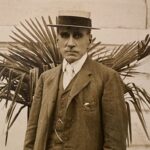
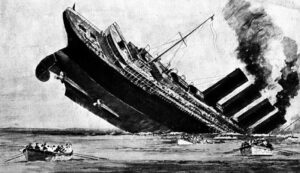 Born in Uruguay 1840, Ramon Artagaveytia was an Argentinian businessman. Even in 1840, businessmen had a need to travel periodically. That is why Artagaveytia found himself on board the ship America when it sank in December 1871. I’m sure the situation was absolutely terrifying, but Artagaveytia, became one of just 65 passengers to survive the disaster. He survived, only by jumping into the water and swimming to safety. I’m sure he felt very fortunate to survive his ordeal, but that is not to say that he was not traumatized. For years, Ramon Artagaveytia, was terrified of travel. Still, while he may have limited his travel, it was still essential at times.
Born in Uruguay 1840, Ramon Artagaveytia was an Argentinian businessman. Even in 1840, businessmen had a need to travel periodically. That is why Artagaveytia found himself on board the ship America when it sank in December 1871. I’m sure the situation was absolutely terrifying, but Artagaveytia, became one of just 65 passengers to survive the disaster. He survived, only by jumping into the water and swimming to safety. I’m sure he felt very fortunate to survive his ordeal, but that is not to say that he was not traumatized. For years, Ramon Artagaveytia, was terrified of travel. Still, while he may have limited his travel, it was still essential at times.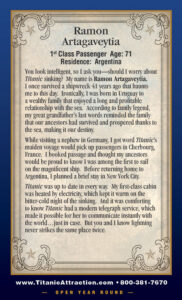
All that changed in 1912, when he wrote a letter to one of his cousins. In his letter, Artagaveytia, expressed relief, saying, “At last I will be able to travel, and, above all, I will be able to sleep calm. The sinking of the America was terrible!… Nightmares keep tormenting me. Even in the most quiet trips, I wake up in the middle of the night with terrible nightmares and always hearing the same fateful word: ‘Fire! Fire! Fire!’… I have even gotten to the point where I find myself standing in the deck with my lifebelt on….”
Artagaveytia was returning to the Americas, following a visit with his nephew in Berlin. As it turned out, the ship that finally put his mind at ease, was the “unsinkable” Titanic. When Artagaveytia arrived at Titanic, he was awed by its luxury. Everyone who saw Titanic was awed by its luxury. For Artagaveytia, one of Titanic’s greatest features was the fact that the ship had telegram capabilities. The promise of instant communication should a crisis arise, brought Artagaveytia great comfort.
Of course, as we all now know, Titanic would not be the ship that would make him safe. Titanic was simply not “unsinkable” because no ship is unsinkable. Titanic would hit that iceberg hiding in the darkness on April 14, 1912, and it would sink, in the early hours of April 15, 1912. Artagaveytia was reportedly seen on one of the decks of Titanic with two fellow passengers, looking as though he wasn’t concerned about the ship actually 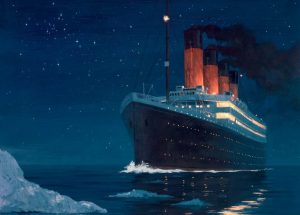
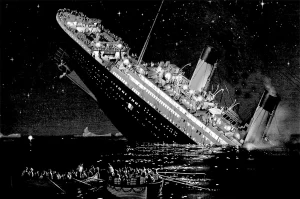 sinking. He had accepted the story that so many people had believed…that somehow, this ship was “unsinkable.” Somehow, he and many others trusted the story above what should have been understood a known fact…that any ship can sink. This time, Artagaveytia would not escape. Artagaveytia’s body was found in the North Atlantic roughly one week after the ship sank to the bottom of the sea.
sinking. He had accepted the story that so many people had believed…that somehow, this ship was “unsinkable.” Somehow, he and many others trusted the story above what should have been understood a known fact…that any ship can sink. This time, Artagaveytia would not escape. Artagaveytia’s body was found in the North Atlantic roughly one week after the ship sank to the bottom of the sea.
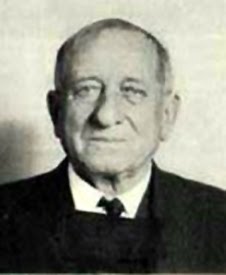
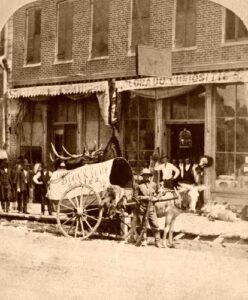 Louis H Blonger was born in Swanton, Vermont, on May 13, 1849. He was the eighth of 13 children. His father, Simon Peter Belonger, was a stonemason born in Canada of French ancestry. His mother, Judith Kennedy, was raised in an orphanage in Nenagh, County Tipperary, Ireland. The Belonger family migrated from Vermont to the lead mining village of Shullsburg, Wisconsin, when Lou was five years old. Sadly, his mother died in 1859, and Lou was sent to live with his older sister and her husband for a few years. It was around that time, that Blonger began using a shortened version of the family name (omitting the first “e”), as most of his brothers did.
Louis H Blonger was born in Swanton, Vermont, on May 13, 1849. He was the eighth of 13 children. His father, Simon Peter Belonger, was a stonemason born in Canada of French ancestry. His mother, Judith Kennedy, was raised in an orphanage in Nenagh, County Tipperary, Ireland. The Belonger family migrated from Vermont to the lead mining village of Shullsburg, Wisconsin, when Lou was five years old. Sadly, his mother died in 1859, and Lou was sent to live with his older sister and her husband for a few years. It was around that time, that Blonger began using a shortened version of the family name (omitting the first “e”), as most of his brothers did.
The Civil War broke out when Lou was just 15 years old. While he was technically just a boy, Lou enlisted in the Union Army anyway. While he was a soldier, someone must have known that he was quite young, and he soon found himself playing a musical instrument called a fife, helping to keep the marching pace of the soldiers. A Fifer was a common job for those boys who were too young to fight. When the war ended, Lou joined up with his older brother, Sam. The boys headed west hoping to make their fortunes in the many Colorado, Utah, and Nevada mining camps. As they were about to find out, mining isn’t the easiest way to make “your fortune” and so they found themselves moving from camp to camp, taking various jobs working in saloons and mines while doing a little prospecting, plenty of gambling, and practicing several con games in cities across the West, from Deadwood, South Dakota, to Silver City, New Mexico, and on to San Francisco, California. For a short time, Lou and Sam even served as lawmen in Albuquerque, New Mexico, where they were said to have provided protection for Doc Holliday and Wyatt Earp.
The brothers could be found in Denver, Colorado by the 1880s, where they ran a saloon on Larimer Street and later on Stout Street. Within ten years, they had become wealthy from their investments in mining claims, as well as their profits from their popular Denver saloons. Their saloons catered to gamblers and provided “painted ladies” for their customers, but it was far more due to their various games of fraud and graft practiced on many 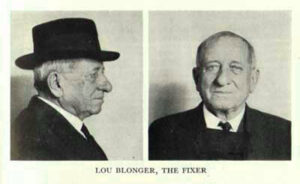 a hapless miner, that brought in the most money for the pair. While in Denver, they practiced their cons widely, in open competition with the well-known Soapy Smith Gang. Eventually, the Blonger brothers took over control as the “Kingpins” of the Denver underworld, when Soapy Smith moved on in 1896. They consolidated the city’s competing gangs of confidence men into a single organization.
a hapless miner, that brought in the most money for the pair. While in Denver, they practiced their cons widely, in open competition with the well-known Soapy Smith Gang. Eventually, the Blonger brothers took over control as the “Kingpins” of the Denver underworld, when Soapy Smith moved on in 1896. They consolidated the city’s competing gangs of confidence men into a single organization.
Operating their “business” as a “big store” con, or fake betting house, central facilities were established, complete with betting windows, chalkboards for race results, and ticker-tape machines. Here, the gang members would convince unsuspecting customers to put up large sums of cash to secure the delivery of promised stock profits or winning bets on horse races. It was this practice that is portrayed in the movie, The Sting. Lou also had several men working for him who profited as pickpockets, shell-game experts, and other small-time con games. Lou’s operation was so tight that no one could operate in the city without gaining his permission and “donating” a share of their proceeds to him. Not satisfied with their original influence, they began to wield their power by influencing elections and political appointments to protect their racket and shield their gang members from prosecution.
Blonger added a second-in-command, named Adolph W “Kid” Duff in 1904. Duff was an experienced hand, having long been a member of several other Colorado gangs and well known as a gambler, opium dealer, and pickpocket. With this addition, the profits of the “organization” increased, and by 1920, Lou Blonger had grown so powerful that many said he “owned” the city of Denver. He was said to be able to fix any arrest with a phone call and was making thousands of illegal dollars a year in his extensive confidence games. Lou even had a private telephone line in his office that ran directly to the chief of police…who was also corrupt. Lou had become known as “The Fixer” and had become one of the leaders of the longest-running confidence rings in the American West. Nevertheless, even this was a doomed enterprise.
Blonger had been a decent young man turned successful criminal for decades, when in 1922, it all ended. Di
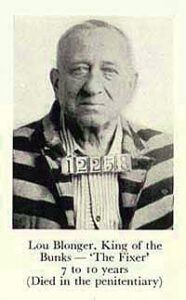 strict Attorney Philip S Van Cise circumvented the corrupt Denver politicians and established his own “secret force” of local citizens. They were funded by private donations, an Van Cise’s men were able to arrest 33 confidence men, including Louis Blonger and “Kid” Duff. The trial was big news and highly publicized. The people were tired of the corruption, and upon their conviction, Louis Blonger and many other gang members were sentenced to prison in Cañon City, Colorado. Lou Blonger and “Kid”, Duff received sentences of seven to ten years, nevertheless, Blonger would again escape hi “due punishment” when just five months after going to prison, he died on April 20, 1924, at the age of 74. Duff, in the meantime, was out on bond pending another court case, when he committed suicide. You might be wondering what Lou’s older brother Sam was doing at this time. Sam had died some ten years earlier.
strict Attorney Philip S Van Cise circumvented the corrupt Denver politicians and established his own “secret force” of local citizens. They were funded by private donations, an Van Cise’s men were able to arrest 33 confidence men, including Louis Blonger and “Kid” Duff. The trial was big news and highly publicized. The people were tired of the corruption, and upon their conviction, Louis Blonger and many other gang members were sentenced to prison in Cañon City, Colorado. Lou Blonger and “Kid”, Duff received sentences of seven to ten years, nevertheless, Blonger would again escape hi “due punishment” when just five months after going to prison, he died on April 20, 1924, at the age of 74. Duff, in the meantime, was out on bond pending another court case, when he committed suicide. You might be wondering what Lou’s older brother Sam was doing at this time. Sam had died some ten years earlier.
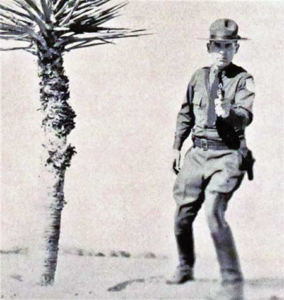 Charles Askins, Jr was an American lawman, US Army officer, and writer. He served in law enforcement, mostly with the US Forest Service and Border Patrol, in the American Southwest prior to the Second World War. He was also known as Colonel Charles “Boots” Askins. He was the son of Major Charles “Bobo” Askins, a sportswriter and Army officer who served in the Spanish American War and World War I, and he was quickly following in his father’s footsteps.
Charles Askins, Jr was an American lawman, US Army officer, and writer. He served in law enforcement, mostly with the US Forest Service and Border Patrol, in the American Southwest prior to the Second World War. He was also known as Colonel Charles “Boots” Askins. He was the son of Major Charles “Bobo” Askins, a sportswriter and Army officer who served in the Spanish American War and World War I, and he was quickly following in his father’s footsteps.
Askins was born in Nebraska on October 28, 1987. The family moved to Oklahoma, where “Boots” Askins was raised. He had several careers in his life, but the first job was fighting forest fires in Montana. Then in 1927, the US Forest Service transferred him to New Mexico to be a Park Ranger at the Kit Carson National Forest. Askins fought fires in New Mexico, until 1930, when he was recruited by the US Border Patrol. Askins wrote in his memoir Unrepentant Sinner, that he had been involved in at least one gunfight every week. I’m sure that work on the US border brought with it a common risk of gunfights. Askins showed great skill, and during his service in the Border Patrol, he won many pistol championships. He was promoted to leader of the Border Patrol’s handgun skills program.
When the United States entered World War II, Askins served in the US Army as a battlefield recovery officer. 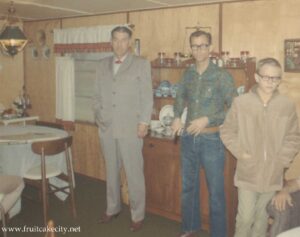 His work took him to North Africa, Italy, and he was in France on D-day. After being discharged from the Army following World War II, he spent several years in Spain as an attaché to the American embassy, helping Franco rebuild Spain’s munition plants. When he completed his assignment in Spain, he was reassigned to Vietnam, where he trained South Vietnamese soldiers in shooting and airborne operations. Askins had an exemplary career in the Army and while he was in the military, he indulged in big game hunting at every opportunity. He continued hunting after his retirement. In his lifetime, he held several big game hunting records, as well as two national pistol championships, an American Handgunner of the Year award, and innumerable smaller titles in competitive shooting. Askins spent his final years in the military at Fort Sam Houston, and he retired to San Antonio, Texas.
His work took him to North Africa, Italy, and he was in France on D-day. After being discharged from the Army following World War II, he spent several years in Spain as an attaché to the American embassy, helping Franco rebuild Spain’s munition plants. When he completed his assignment in Spain, he was reassigned to Vietnam, where he trained South Vietnamese soldiers in shooting and airborne operations. Askins had an exemplary career in the Army and while he was in the military, he indulged in big game hunting at every opportunity. He continued hunting after his retirement. In his lifetime, he held several big game hunting records, as well as two national pistol championships, an American Handgunner of the Year award, and innumerable smaller titles in competitive shooting. Askins spent his final years in the military at Fort Sam Houston, and he retired to San Antonio, Texas.
Askins inherited his writing skills from his father, “Bobo” Askins. “Boots” Askins was a creative writer, with a 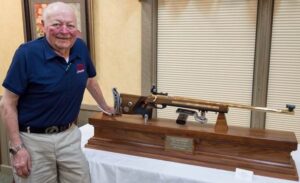 number of books and over 1,000 magazine articles on subjects related to hunting and shooting. His writing career spanned 70 years, from 1929 until his death in March of 1999. While he was an excellent, his writings were considered controversial, mostly because he liked to graphically describe the numerous fatal shootings in his law enforcement and military careers, stating he had killed “27, not counting blacks and Mexicans.” He even once described himself as possibly a “psychopathic killer, and that he hunted animals so avidly because he was not allowed to hunt men anymore.” I suppose his killings were “justified” but maybe not really ethical. Still, many of them were necessary. He died on March 2, 1999, at the age of 91.
number of books and over 1,000 magazine articles on subjects related to hunting and shooting. His writing career spanned 70 years, from 1929 until his death in March of 1999. While he was an excellent, his writings were considered controversial, mostly because he liked to graphically describe the numerous fatal shootings in his law enforcement and military careers, stating he had killed “27, not counting blacks and Mexicans.” He even once described himself as possibly a “psychopathic killer, and that he hunted animals so avidly because he was not allowed to hunt men anymore.” I suppose his killings were “justified” but maybe not really ethical. Still, many of them were necessary. He died on March 2, 1999, at the age of 91.
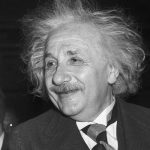
 Many advancements have been made in our world through the studies of science. Still, sometimes, scientists take their study of science just a little bit too far, in the name of science. There isn’t a person in the world who hasn’t heard of Albert Einstein. He was not only the iconic, but common to geniuses, Einstein was also eccentric. Nevertheless, he was a brilliant scientist, mathematician, and one of the most intelligent people in history. Because of his brilliance, Einstein also knew that upon his death, there would undoubtedly be some crazy scientist who would want to study his brain. I can’t imagine knowing that my brain would be in demand, and in fact might be stolen after I had died. That seems totally insane to me, but for Einstein, it was a very real possibility. Knowing that, Einstein left detailed instructions to cremate his body and not to allow any brain examinations.
Many advancements have been made in our world through the studies of science. Still, sometimes, scientists take their study of science just a little bit too far, in the name of science. There isn’t a person in the world who hasn’t heard of Albert Einstein. He was not only the iconic, but common to geniuses, Einstein was also eccentric. Nevertheless, he was a brilliant scientist, mathematician, and one of the most intelligent people in history. Because of his brilliance, Einstein also knew that upon his death, there would undoubtedly be some crazy scientist who would want to study his brain. I can’t imagine knowing that my brain would be in demand, and in fact might be stolen after I had died. That seems totally insane to me, but for Einstein, it was a very real possibility. Knowing that, Einstein left detailed instructions to cremate his body and not to allow any brain examinations.
As sometimes happens, even when a detailed and legal will is written, there are those who do not necessarily think that it needs to be followed. I think that is just heinous!! When Einstein died in 1955, a scientist named Thomas Stoltz Harvey conducted the autopsy. This man completely disregarded the will that was written by Albert Einstein, and despite the family not granting permission, he stole Einstein’s brain and took it to the University of Philadelphia to study it. When they found out about the theft, Einstein’s family decided to give  permission to Harvey to go ahead and study Einstein’s brain, as long as he published the finding in a scientific magazine. At that point they had few other options. Still, I believe it was a criminal act, and Harvey should have been punished to the fullest extent of the law.
permission to Harvey to go ahead and study Einstein’s brain, as long as he published the finding in a scientific magazine. At that point they had few other options. Still, I believe it was a criminal act, and Harvey should have been punished to the fullest extent of the law.
After, Harvey stole Einstein’s brain, “it was preserved, photographed, dissected, and even mailed to other scientists in hopes that studying it might uncover the source of his genius. Over decades, several interesting features of his brain have been discovered, including more extensive connections between the two hemispheres of his brain, a lighter than average weight, and an enlarged lateral sulcus. The part of his brain dedicated to mathematical and spatial thought, the inferior parietal lobe, was larger than average as well.” These days, you can view his brain (now with permission from his family)…or what is left of it after the mutilation it was subjected to, in the permanent exhibitions of the Mütter Museum in Philadelphia, Pennsylvania.
I don’t think “in the name of science” should be a license to steal something that belongs to someone else. Their body parts, whether needed for a transplant or for scientific study, should not be allowed. If a person wanted their body donated for science or transplant, they would have stated as much. I understand a family allowing a transplant if no specific instructions were given, but when specific instructions were given, as in the case of Albert Einstein, how dare someone decide that their desires are more important than the desires of the 
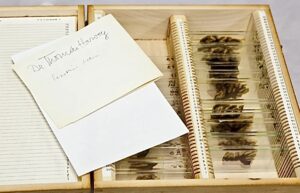 deceased!! Once the damage was done, and the brain was stolen, Einstein’s family made the decision not to prosecute, but rather to allow the scientific testing. It was a gracious move on their part, and an act of mercy that was most certainly not earned by one Thomas Stoltz Harvey!! I also speculate that it could have opened the door for additional victims…allowed in the name of science. This was just wrong…in so many ways!!
deceased!! Once the damage was done, and the brain was stolen, Einstein’s family made the decision not to prosecute, but rather to allow the scientific testing. It was a gracious move on their part, and an act of mercy that was most certainly not earned by one Thomas Stoltz Harvey!! I also speculate that it could have opened the door for additional victims…allowed in the name of science. This was just wrong…in so many ways!!
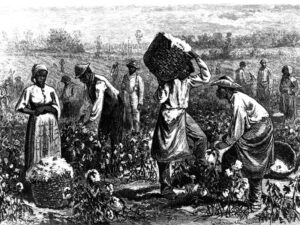
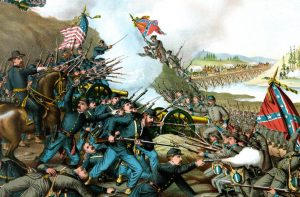 Most of us think that after the Civil War, the South simply accepted defeat and went on to become model citizens of the new America…the one without slavery. That was not the case, however. First of all, there were a number of plantation owners in the South, who just didn’t tell their slaves that they were free now. Finally, after being forced to do so, the announcement came, a whole two months after the effective conclusion of the Civil War, and even longer since Abraham Lincoln had first signed the Emancipation Proclamation. Nevertheless, even after that day, many enslaved black people in Texas still weren’t free. That part was bad enough, but that wasn’t all there was to it.
Most of us think that after the Civil War, the South simply accepted defeat and went on to become model citizens of the new America…the one without slavery. That was not the case, however. First of all, there were a number of plantation owners in the South, who just didn’t tell their slaves that they were free now. Finally, after being forced to do so, the announcement came, a whole two months after the effective conclusion of the Civil War, and even longer since Abraham Lincoln had first signed the Emancipation Proclamation. Nevertheless, even after that day, many enslaved black people in Texas still weren’t free. That part was bad enough, but that wasn’t all there was to it.
We have heard people say that if this or that president gets into office, they are leaving the country. People have also left the country because they didn’t want to fight is a war. However, I had never heard that 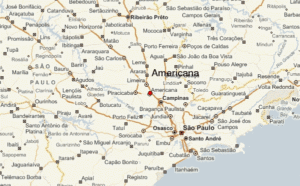 approximately 20,000 Confederates decided to actually leave the country. They went to Brazil after the Civil War to create a kingdom built on slavery. These people were so set on their lifestyle that they were willing to pull up stakes and start over in order to keep their slaves and their slavery lifestyle. The reality was that after four bloody years of war, the Confederacy virtually crumbled in April 1865. Nevertheless, a rather large group of the Confederates were not ready to accept defeat.
approximately 20,000 Confederates decided to actually leave the country. They went to Brazil after the Civil War to create a kingdom built on slavery. These people were so set on their lifestyle that they were willing to pull up stakes and start over in order to keep their slaves and their slavery lifestyle. The reality was that after four bloody years of war, the Confederacy virtually crumbled in April 1865. Nevertheless, a rather large group of the Confederates were not ready to accept defeat.
Instead, as many as 20,000 of them fled south. They relocated to Brazil, where a slaveholding culture already existed. There, they hoped the country’s culture could help them preserve their traditions. Once there, they cooked Southern food, spoke English, and tried to buy enough slaves to resurrect the pre-Civil War plantation system. These people, known as Confederados, were enticed to Brazil by offers of cheap land from Emperor Dom Pedro II, who had hoped to gain expertise in cotton farming. Initially, most of these so-called Confederados settled in the current state of São Paulo, where they founded the city of Americana, which was once part of the neighboring city of Santa Bárbara d’Oeste. The descendants of other Confederados would later be found throughout Brazil. They were very happy with their decision to leave the United States, and very 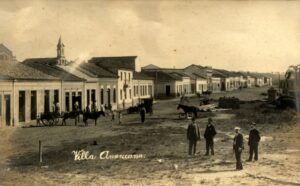
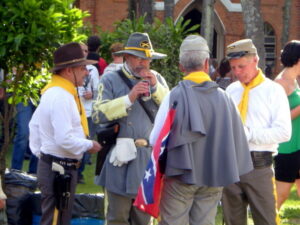 happy that they could continue to keep slaves. Nevertheless, their “victory” was not without loss too. They had to give up their citizenship in the United States, and I have to wonder if their lives have turned out as they hoped they would, or if they are living in much poorer conditions in Brazil. Nevertheless, they stayed, and to this day, the so-called Confederados gather each year to fly the Confederate flag and celebrate their lost heritage.
happy that they could continue to keep slaves. Nevertheless, their “victory” was not without loss too. They had to give up their citizenship in the United States, and I have to wonder if their lives have turned out as they hoped they would, or if they are living in much poorer conditions in Brazil. Nevertheless, they stayed, and to this day, the so-called Confederados gather each year to fly the Confederate flag and celebrate their lost heritage.

 During World War II, Hitler was terrorizing people, especially the Jews, Gypsies, and even Blacks. Hitler wanted to create an Aryan race dominate society, and truly preferred that anyone who did not fit that “mold” be removed from the Earth. The Aryan race consisted of tall, blonde-haired blue-eyed people, which is odd, considering the fact that Hitler was short (5’9″), and had brown hair. He did have blue eyes, but that was about the only part of him that fit the “mold” of the Aryan race. Nevertheless, he terrorized many people and for that reason, many people tried to escape the occupied areas of Europe, like France to the free areas like Spain.
During World War II, Hitler was terrorizing people, especially the Jews, Gypsies, and even Blacks. Hitler wanted to create an Aryan race dominate society, and truly preferred that anyone who did not fit that “mold” be removed from the Earth. The Aryan race consisted of tall, blonde-haired blue-eyed people, which is odd, considering the fact that Hitler was short (5’9″), and had brown hair. He did have blue eyes, but that was about the only part of him that fit the “mold” of the Aryan race. Nevertheless, he terrorized many people and for that reason, many people tried to escape the occupied areas of Europe, like France to the free areas like Spain.
One of the routes was to go across the ridge of the Pyrenees Mountain range, in order to cross the border into  the “promised land,” the neutral territory of Spain, to find a way of escape, a second chance, a future. It was a perilous route to go through the Pyrenees mountains, but it provided a means for hundreds of thousands of resistance fighters, civilians, Jews, allied soldiers and escaped prisoners of war to evade Nazi pursuers. Failure was not an option, because behind them was Nazi-occupied France, bringing certain imprisonment or death. Many of the travelers had come quite a distance, helped by resistance fighters and citizens who disagreed with all that was going on with the Nazi regime. The perilous journey up through rocky boulder fields and frozen glaciers was the final stretch in a long and dangerous trek across wartime Europe, hiding from German military, Gestapo secret police and SS paramilitary forces.
the “promised land,” the neutral territory of Spain, to find a way of escape, a second chance, a future. It was a perilous route to go through the Pyrenees mountains, but it provided a means for hundreds of thousands of resistance fighters, civilians, Jews, allied soldiers and escaped prisoners of war to evade Nazi pursuers. Failure was not an option, because behind them was Nazi-occupied France, bringing certain imprisonment or death. Many of the travelers had come quite a distance, helped by resistance fighters and citizens who disagreed with all that was going on with the Nazi regime. The perilous journey up through rocky boulder fields and frozen glaciers was the final stretch in a long and dangerous trek across wartime Europe, hiding from German military, Gestapo secret police and SS paramilitary forces.
The Freedom Trail, whose final ascent has a zig-zag path through an ice sheet, is an annual “walking memorial” 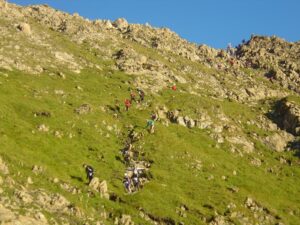
 these days. People, some of them descendants of the original people who walked the trail in a desperate run for their lives, walk to remember those who went before them to freedom, those who could not make the journey and lost their lives, and those who lost their lives on the trail itself. The area really is quite beautiful, but I’m sure it didn’t feel that way to those who were running for their lives.
these days. People, some of them descendants of the original people who walked the trail in a desperate run for their lives, walk to remember those who went before them to freedom, those who could not make the journey and lost their lives, and those who lost their lives on the trail itself. The area really is quite beautiful, but I’m sure it didn’t feel that way to those who were running for their lives.
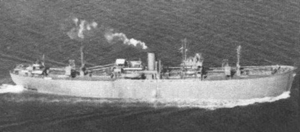
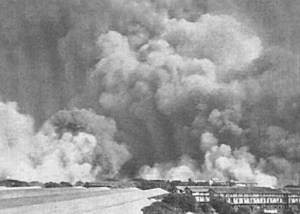 When a ship explodes in a port, the first assumption is that terrorists attacked, but that is not always the case. On April 14, 1944, cargo ship Fort Stikine exploded in a berth in the docks of Bombay, India, which is now known as Mumbai. The catastrophic explosion killed 1,300 people and injured another 3,000. It’s possible that the reason it was considered terrorists, or in this case, Japanese sabotage, was because the incident happened during World War II. Nevertheless, the explosion was actually caused by a tragic accident.
When a ship explodes in a port, the first assumption is that terrorists attacked, but that is not always the case. On April 14, 1944, cargo ship Fort Stikine exploded in a berth in the docks of Bombay, India, which is now known as Mumbai. The catastrophic explosion killed 1,300 people and injured another 3,000. It’s possible that the reason it was considered terrorists, or in this case, Japanese sabotage, was because the incident happened during World War II. Nevertheless, the explosion was actually caused by a tragic accident.
The ship, The Fort Stikine was a Canadian-built steamship weighing 8,000 tons. On February 24, Fort Stikine left Birkenhead, England, making a stop in Karachi, Pakistan, before continuing on to dock at Bombay. The cargo on Fort Stikine that day included hundreds of cotton bales, gold bullion and, most notably, 300 tons of trinitrotoluene, better known as TNT or dynamite. I’m sure you can begin to get a picture of what might have triggered this tragic accident. Despite the well-known fact that cotton bales were prone to combustion, the 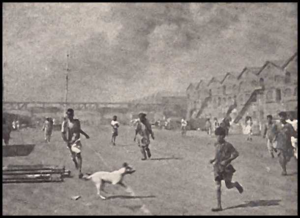 cotton was stored one level below the dynamite. I’m sure that with a little imagination, you can probably guess what happened next.
cotton was stored one level below the dynamite. I’m sure that with a little imagination, you can probably guess what happened next.
While the ship was being loaded with her cargo, someone noticed smoke coming from the cotton bales. Firefighters were sent to investigate, but emergency measures, such as flooding that part of the ship, were not immediately taken. Instead, about 60 firefighters tried to put out the fire with hoses throughout the afternoon. For some reason, the TNT was not unloaded during the firefighting efforts, creating a recipe for disaster. Before long, it became clear that the firefighters were not going to be able to get control of the fire, and they were ordered off the ship, but they kept dousing the fire from the docks. Unfortunately, their efforts were in vain. The TNT ignited, and at 4:07pm, and the resulting explosion rocked the bay area. The initial force of the blast actually lifted a nearby 4,000-ton ship from the bay onto the land. Windows shattered up to a mile away. A 28-pound gold bar from the Fort Stikine, worth many thousands of dollars, was found a mile away. Everyone in close vicinity of the ship was killed.
In addition to the Fort Stikine, twelve other ships at the docks were destroyed and many more were seriously damaged. The initial blast threw burning debris all over the port. Fires broke out, causing further explosions. In 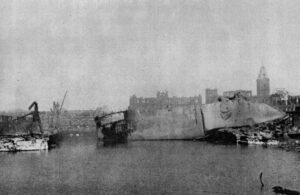
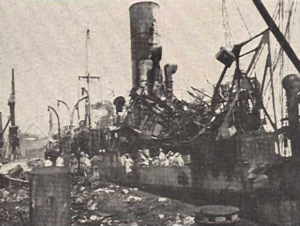 desperation, military troops were brought in to fight the raging fires and some buildings were demolished just to stop it from spreading. For three days after the explosion, the main business center of Bombay was not safe for anyone to be in. A valuable lesson was learned, but at a horrible price. So many lives lost to learn that cotton and TNT should probably never be on the same ship, but if they are, the cotton should never be stored right below the TNT.
desperation, military troops were brought in to fight the raging fires and some buildings were demolished just to stop it from spreading. For three days after the explosion, the main business center of Bombay was not safe for anyone to be in. A valuable lesson was learned, but at a horrible price. So many lives lost to learn that cotton and TNT should probably never be on the same ship, but if they are, the cotton should never be stored right below the TNT.

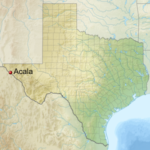 Acala, Texas was once a “thriving” community…well, ok, maybe not exactly thriving, but it the town’s “heydays” it had a population of about 100 people, who made a living raising Acala Cotton. No, it never was big, but the railroad once went through there to take the cotton crop to the market. Acala is located in Hudspeth County, Texas, approximately 34 miles northwest of Sierra Blanca and 54 miles southeast of El Paso on Highway 20. These days the population is approximately 25 people, making Acala more of a ghost town than the unincorporated community that it is technically listed as.
Acala, Texas was once a “thriving” community…well, ok, maybe not exactly thriving, but it the town’s “heydays” it had a population of about 100 people, who made a living raising Acala Cotton. No, it never was big, but the railroad once went through there to take the cotton crop to the market. Acala is located in Hudspeth County, Texas, approximately 34 miles northwest of Sierra Blanca and 54 miles southeast of El Paso on Highway 20. These days the population is approximately 25 people, making Acala more of a ghost town than the unincorporated community that it is technically listed as.
The area was first settled in the early 20th century. In 1917, three farmers combined their resources to plant experimental cotton near Tornillo, about 13 miles northwest of what is now Acala, Texas. Successful the first year, the men purchased more land the next year to grow irrigated cotton. Hearing about the success of these f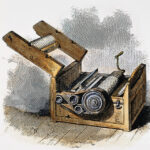 armers, a man named WT Young came to the area from El Paso to try his hand at cotton farming, but Young would bring much more to the area than cotton. He bought a large piece of cheap desert land near the Southern Pacific Railroad tracks southeast of Tornillo. Using mules to clear the brush and break the soil for the first time, he planted a Mexican variety of cottonseed called Acala. He was so successful that he built his own cotton gin at the site now known as Acala. It wasn’t the first cotton gin, which was built by Eli Whitney, but it was a cotton gin, and it revolutionized Acala.
armers, a man named WT Young came to the area from El Paso to try his hand at cotton farming, but Young would bring much more to the area than cotton. He bought a large piece of cheap desert land near the Southern Pacific Railroad tracks southeast of Tornillo. Using mules to clear the brush and break the soil for the first time, he planted a Mexican variety of cottonseed called Acala. He was so successful that he built his own cotton gin at the site now known as Acala. It wasn’t the first cotton gin, which was built by Eli Whitney, but it was a cotton gin, and it revolutionized Acala.
The town began to grow, and a post office was established in 1925. It was operated by Mrs Julia Vaughn. By 1929, the population had doubled from 50 people to its peak of 100 people. The population varied over the years, peaking again in the late 1950s, at 100 people. Unfortunately, the town could not maintain the population, and soon declined, once again. By the 1970’s there were about 25 people. Since then, it has remained at that size. Acala is in the Fort Hancock Independent School District. Fort Hancock High School is the district’s comprehensive high school.
The United States Census Bureau first listed Acala as a census-designated place prior to the 2020 census. A 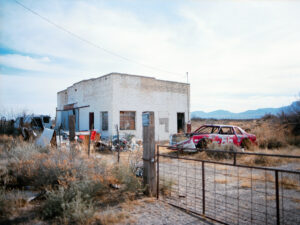
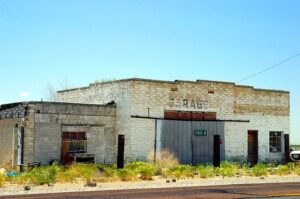 census-designated place (CDP) is a statistical geography representing closely settled, unincorporated communities that are locally recognized and identified by name. The designation doesn’t necessarily add any importance or value to the town, however. Nevertheless, the fact that it was at one time a successful agricultural area and operated a successful cotton gin, gives it definite historical value.
census-designated place (CDP) is a statistical geography representing closely settled, unincorporated communities that are locally recognized and identified by name. The designation doesn’t necessarily add any importance or value to the town, however. Nevertheless, the fact that it was at one time a successful agricultural area and operated a successful cotton gin, gives it definite historical value.
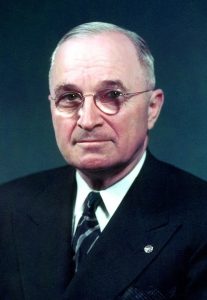 In any “job” or “career” there can be conflicts. Sometimes it’s all about workmanship, and other times it’s a personality conflict. Probably the most famous of these conflicts was the civilian-military confrontation between President Harry S Truman and General Douglas MacArthur who was in command of the US forces in Korea. When Truman relieved MacArthur of duty, in reality, firing him, it set off a brief uproar among the American public. Nevertheless, Truman was determined to keep the conflict in Korea a “limited war” at all costs.
In any “job” or “career” there can be conflicts. Sometimes it’s all about workmanship, and other times it’s a personality conflict. Probably the most famous of these conflicts was the civilian-military confrontation between President Harry S Truman and General Douglas MacArthur who was in command of the US forces in Korea. When Truman relieved MacArthur of duty, in reality, firing him, it set off a brief uproar among the American public. Nevertheless, Truman was determined to keep the conflict in Korea a “limited war” at all costs.
General MacArthur was considered flamboyant and egotistical, and problems between him and President Truman had been brewing for months. The Korean War began in June of 1950, and in those early days of the war in Korea, MacArthur had devised some brilliant strategies and military maneuvers that helped save South Korea from falling to the invading forces of communist North Korea. As United States and United Nations forces began turning the tide of battle in Korea, MacArthur began to argue for a policy of pushing into North Korea to completely defeat the communist forces. Truman initially went along with the plan, but he was also worried that the communist government of the People’s Republic of China might take the invasion as a hostile act and intervene in the conflict. Thus began a battle of wills between the two men. MacArthur met with Truman in October 1950, and assured him that the chances of a Chinese intervention were slim.
Unfortunately, that “slim chance” materialized in November and December 1950, when hundreds of thousands of Chinese troops crossed into North Korea and throwing themselves against the American lines, driving the US troops back into South Korea. At that point, MacArthur requested permission to bomb communist China and use Nationalist Chinese forces from Taiwan against the People’s Republic of China. Truman refused these requests point blank, and a very public and very heated argument began to develop between the two men.
Then, in April 1951, President Truman fired MacArthur and replaced him with General Matthew Ridgway. The nation was outraged, but on April 11, Truman addressed the nation and explained his actions. Truman defended his overall policy in Korea, by declaring, “‘It is right for us to be in Korea.’ He excoriated the ‘communists in the Kremlin [who] are engaged in a monstrous conspiracy to stamp out freedom all over the world.’ Nevertheless, he explained, it ‘would be wrong—tragically wrong—for us to take the initiative in extending the war… Our aim is to avoid the spread of the conflict.’ The president continued, ‘I believe that we must try to limit the war to 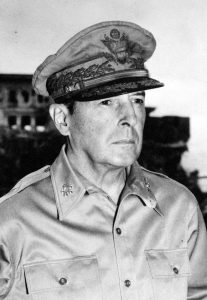 Korea for these vital reasons: To make sure that the precious lives of our fighting men are not wasted; to see that the security of our country and the free world is not needlessly jeopardized; and to prevent a third world war.’ General MacArthur had been fired ‘so that there would be no doubt or confusion as to the real purpose and aim of our policy.'”
Korea for these vital reasons: To make sure that the precious lives of our fighting men are not wasted; to see that the security of our country and the free world is not needlessly jeopardized; and to prevent a third world war.’ General MacArthur had been fired ‘so that there would be no doubt or confusion as to the real purpose and aim of our policy.'”
Nevertheless, MacArthur returned to the United States to a hero’s welcome. “Parades were held in his honor, and he was asked to speak before Congress (where he gave his famous ‘Old soldiers never die, they just fade away’ speech). Public opinion was strongly against Truman’s actions, but the president stuck to his decision without regret or apology. Eventually, MacArthur did ‘just fade away,’ and the American people began to understand that his policies and recommendations might have led to a massively expanded war in Asia. Though the concept of a ‘limited war,’ as opposed to the traditional American policy of unconditional victory, was new and initially unsettling to many Americans, the idea came to define the U.S. Cold War military strategy.”

